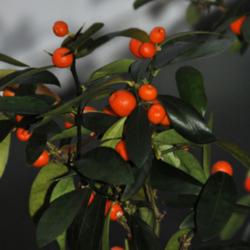| We purchased two miniature trees which are showing signs of wilting and curling, and in the case of the Kumquat, turning brown as if burned. The kumquat flowered and produced many fruit but seems stunted. I repotted it in a bigger container but is not flourishing. The orange tree bloomed and began to set fruit but dropped them. Is starting to bloom again but leaves look lifeless and about 20% of leaves are curled. I have not repotted the Orange because have not seen any real improvement in the kumquat. The nursery said to give it ample MiracleGro which hasn't changed anything. |

Another possible culprit is Citrus Mesophyll Collapse. Grapefruits are particularly susceptible but any citrus may be affected. It is not uncommon for grapefruit trees to be affected and other nearby citrus to be fine. Leaves and fruit of citrus trees dry up and drop. Stems and branches remain green and living. Rarely is the whole tree affected. Mesophyll collapse occurs when there are unseasonable weather changes. For example if it gets abnormally cold in October for several days and then heats back up above average temperature in November. This fluctuation stresses the trees as they kick into and out of and then back into their winter slow down. It is especially stressful after a dry summer. Brown/burned looking leaves may be a sign of salt burn. Browning usually occurs on the old leaves first. This excess salt accumulates in the leaf edges, where it kills the tissue and the leaf dries out and turns brown. It's important to water deeply, slowly and infrequently. At least once a month, water deeply enough to "leach" or push salts below the root zone. Frequent, light "sprinklings" allow salts to accumulate in the top layers of soil, where the roots are, which is bad news. Similar symptoms occur when too much fertilizer has been applied. Citrus are heavy feeders and do need a regular fertilizing program. Be sure to water well before and after applying to help prevent burn. If possible, buy a fertilizer formulated for citrus. |